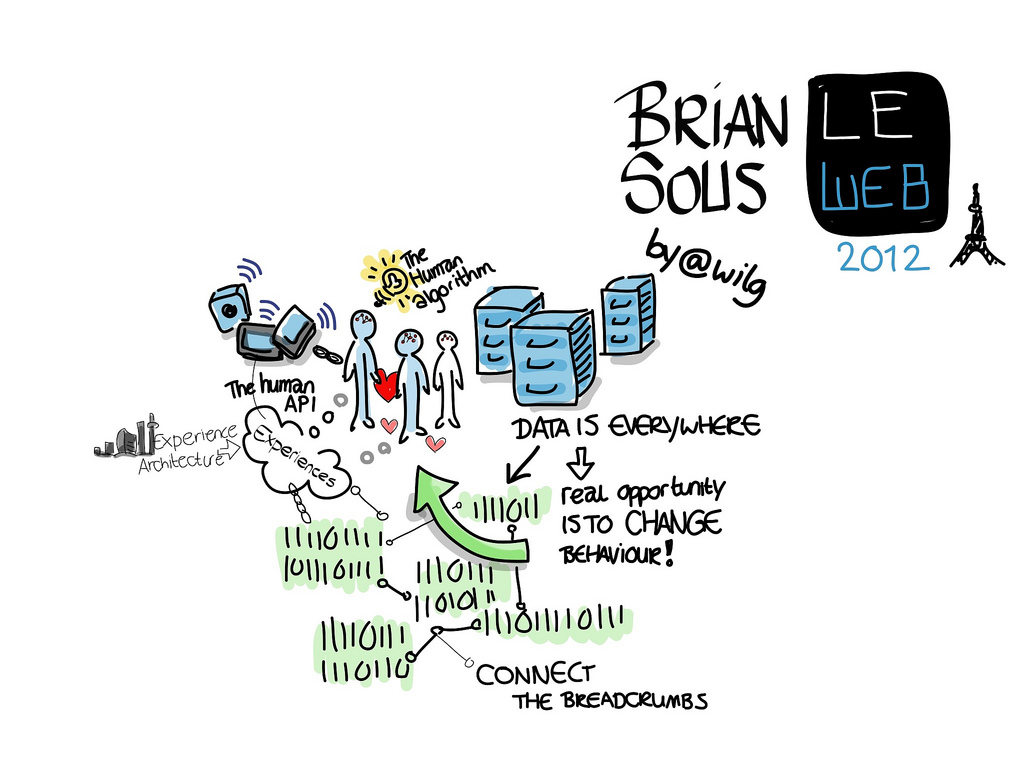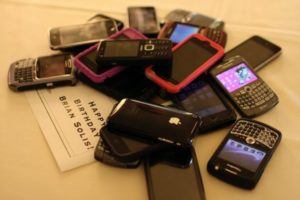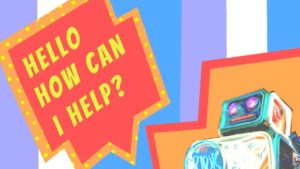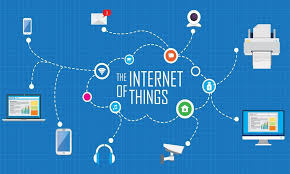
In 2012, I had the opportunity to present at LeWeb in Paris. The theme of the conference explored the Internet of Things, where devices and things connect to one another to perform certain tasks and/or track activities to improve what we already do or make possible what we’re trying to do.
The Internet of Things is bigger than we may realize. We are experiencing a shift from a world of inanimate objects and reactive devices to a world where data, intelligence, and computing are distributed, ubiquitous, and networked. My fellow analysts and I at Altimeter Group refer to the Internet of Things (IoT) as the Sentient World. It’s the idea that inanimate objects gain the ability to perceive things, perform tasks, adapt, or help you adapt over time. And, it’s the future of the Internet and consumer electronics.
The number of things connected to the Internet in 2008, exceeded the number of people on earth. By 2020, it’s expected that there will be 50 billion things connected.
A network of things creates an incredible information ecosystem that connects the online and physical world through a series of transactions. In a world where data becomes a natural bi-product of these exchanges, developers, businesses, and users alike are faced with the reality that data isn’t only big, its volume and benefits are also overwhelming.
Did you know that the world creates 2.5 quintillion bytes of new data every day? According to IBM, 90% of the data in the world today has been created in the last two years alone.
Considering the relationship between the Internet, data, and devices, I can’t help but think about Marshall McLuhan’s ominous words, “The more data banks record about each one of us, the less we exist.”
With the Internet of Things, that data takes residence in the cloud with various devices and apps siphoning and funneling information in and out, requiring an incredible amount of vision and architecture to organize, analyze, and present it in a way that makes sense while also offering insight and utility. Instead of eclipsing our individuality, I believe the future may reveal the exact opposite. There’s a sense of empowerment and personalization that emerges and, along the way, we subconsciously and consciously begin to crave it. We become insatiable in our pursuit of personalized feedback and it may, in fact, define us.
The Convergence of Devices, Data and the Net
We’re starting to realize the magic of the IoT today in some of the most basic aspects of our lives. While at Le Web, the audience was introduced to Lockitron, a clever system that combines a mobile app, a household device that mounts to existing door locks, and the Internet to open and close doors remotely. I immediately thought of a partnership with Airbnb to give renters peace of mind in controlling their rentals.
Nest is disrupting the long dormant world of thermostats by connecting mobile devices to existing thermostats (heating/air conditioning) with the simplicity and elegance of an iPod. But it’s more than controlling energy and temperatures remotely, Nest learns and begins to adapt without input.
Square’s Jack Dorsey has disrupted the age old world of payment systems by transforming mobile devices into cash registers, connecting money, data, and the net into one frictionless transaction. It’s the data part that represents something so much more however. In that regard, Dorsey sees the real value beyond the transaction—where the swipe and the receipt ultimately become a communication medium. In his view, payments represent “a necessary transaction” to create a channel where merchants learn more about individual consumers and equally, consumers learn more about their behavior.
The Convergence of People, Devices, Data and the Net
When I marvel at the future of the Internet of Things, I can’t help but think about another often shared idea from McLuhan that, “the medium is the message.”
There’s more to smart appliances and devices than utility or remotely controlling our surroundings. The underlying current of this powerful information exchange are the experiences that surround and emanate from each transaction.
What if the medium wasn’t just the device, the medium was us?
At the center of the IoT and Big Data are the very people who fuel the constant exchange of information. At the same time, it creates a human network, where we become nodes and the information that ties together people and devices feeds new experiences and changes our behavior over time.
This is an era of which I refer to as the Human API, the idea that who we are, who we know, what we experience and do are important layers in the Internet of Things. While this may sound foreboding, we do in fact become part of the “machine.” I’m not referring to Skynet or Raymond Kurzweil’s theory of Singularity, however. I’m talking about how we open the door to a new generation of technology development that improves lifestyles and enhances relationships while unlocking aspirations.
If you’re unfamiliar with the meaning of API, it stands for application programming interface. Simplified, it’s an interface for programmers to develop upon a common platform where software can communicate with other software objects and also devices.
The Human API represents an opportunity for relationships and technology to be linked by an open source platform…you.
The Medium IS the Message
Revisiting McLuhan’s “medium is the message,” where the form of a medium embeds itself in the message, as a result, it creates a symbiotic relationship by which the medium influences how the message is perceived. The idea of the Human API sets the stage for devices to not only talk to one another, but also talk to us and affect how we process and adapt information to influence how we go through life every day.
If we intentionally program for the Human API, I believe we can design a complementary track within the Internet of Things where products combine utility, experiences, and outcomes.
Let me give you a simple example. Fitbit, makers of wireless trackers and scales, had a tremendous presence at LeWeb. Many speakers and attendees wore these wireless devices to track steps, distance, calories burned, and stairs climbed. At night, it measures sleep cycles, to help users learn how to sleep better. The intention is to motivate you to reach your goals by bringing greater fitness into your life. It is the social element and the corresponding activity that I also find fascinating.
Products such as Fitbit and also Nike’s FuelBand build upon the Human API by collecting the digital breadcrumbs of users and assembling them in a way that makes sense of daily activity and validates progress. Perhaps more importantly, these devices, the data they collect and present, and the social relationships linked by publishing this information in social channels drives the ongoing pursuit of goals, and brings people together to help one another live better. As these devices are connected socially, experiences become the epicenter of engagement and encouragement, inspiring people and networks of people through extended relationships along the way.
That’s the point.
Over the years, many developers have created specialized apps and devices that helped us accomplish things through creative “life hacks.” These hacks have given us a taste of what’s possible and are now about to become a way of life. To do so, they now require intentional design to create desired experiences and to change behavior and bring about thoughtful outcomes.
The Human API and the Need for Experience Architecture
Designing new threads within the Internet of Things around people, information, and devices requires architecture. Rather than exploring the deeper convergence of human and machine (“singularity”), the idea of solidarity seems more apropos here and now. I’m not referring to the trade union movement in Poland during the 1980s that inspired opposition to communist regimes across Eastern Europe. I think of solidarity in this case as a movement where individuals come together around a common interest to promote mutual support within the group.
Developing solutions that spark solidarity is only possible through experience architecture. This is where the next generation of visionaries and leaders will push us forward for they represent an emergent genre of experience architects.
This is where you come in…
The Human API opens up tremendous opportunities to develop devices, apps, and experiences that connect information, people, and aspirations to change behavior. This form of human interface design introduces the potential to create harmony in a world of digital chaos, making sense of noise and information overload to accomplish tangible goals or help people see or do things they didn’t or couldn’t before. In the process, we strengthen on our connections around common goals and interests.
This raises questions that experience architects need to consider:
- What does all of this tell us about ourselves and those around us?
- How do our devices better communicate and improve how we communicate and adapt?
- How does the IoT bring people together around a purpose, outcomes, or aspirations?
- How does it enable us to optimize the lives of our users and customers?
The future of the Internet of Things requires the balance of experience architecture and the exchange of human information between people and machines, and it is beautiful. And, it takes design.
Imagine what we—as users, entrepreneurs, investors, and enterprises—could do with all of this information. Imagine how we can improve connectivity, lifestyles, and relationships by constructing ecosystems that foster meaningful experiences and inspire changes in behavior.
This hyper-connected world will bring devices, systems, information and people closer together … to create new possibilities, all based on human APIs. As experience architects, the future is yours to develop.
What are your thoughts on the idea of the relationship between people, devices, the Internet of Things? Let’s keep the conversation going!
Below is video of my presentation at LeWeb on the Human API. I hope you enjoy it.
Brian Solis
Brian Solis is principal analyst and futurist at Altimeter, the digital analyst group at Prophet, Brian is world renowned keynote speaker and 7x best-selling author. His latest book, X: Where Business Meets Design, explores the future of brand and customer engagement through experience design.
Invite him to speak at your event or bring him in to inspire and change executive mindsets.
Connect with Brian!
Twitter: @briansolis
Facebook: TheBrianSolis
LinkedIn: BrianSolis
Instagram: BrianSolis
Youtube: BrianSolisTV





Leave a Reply